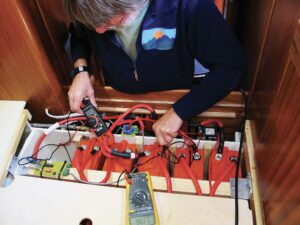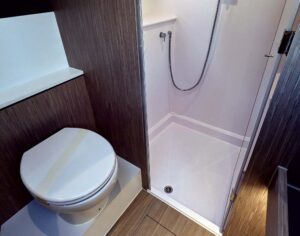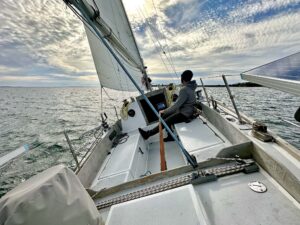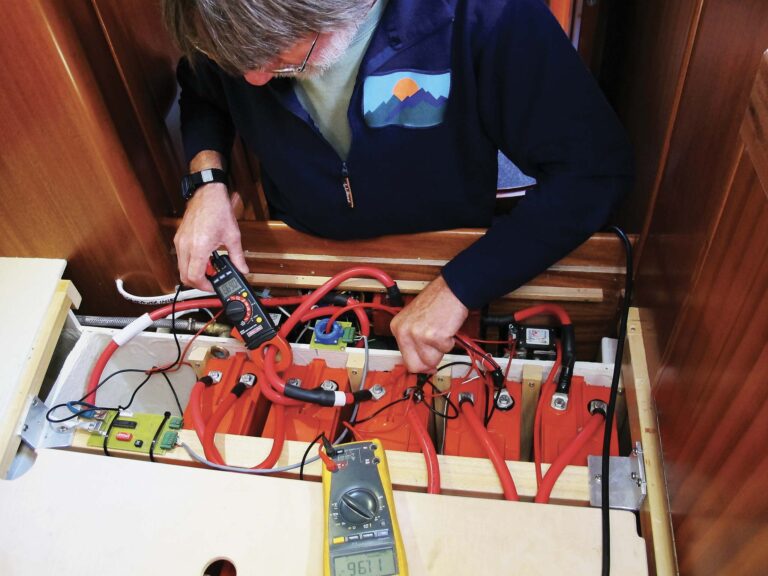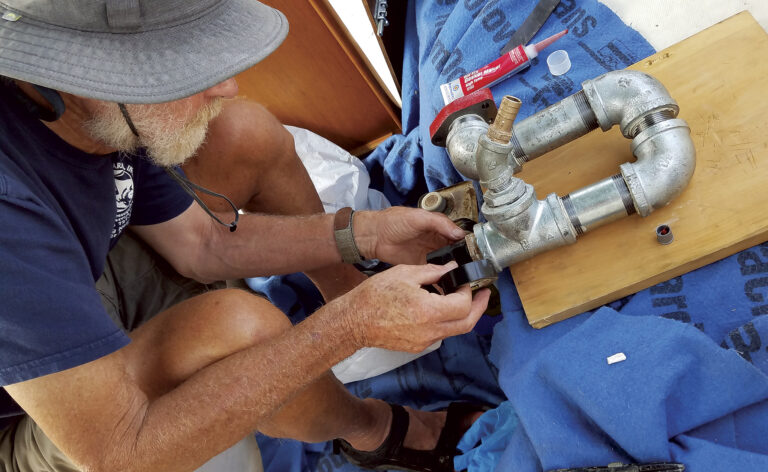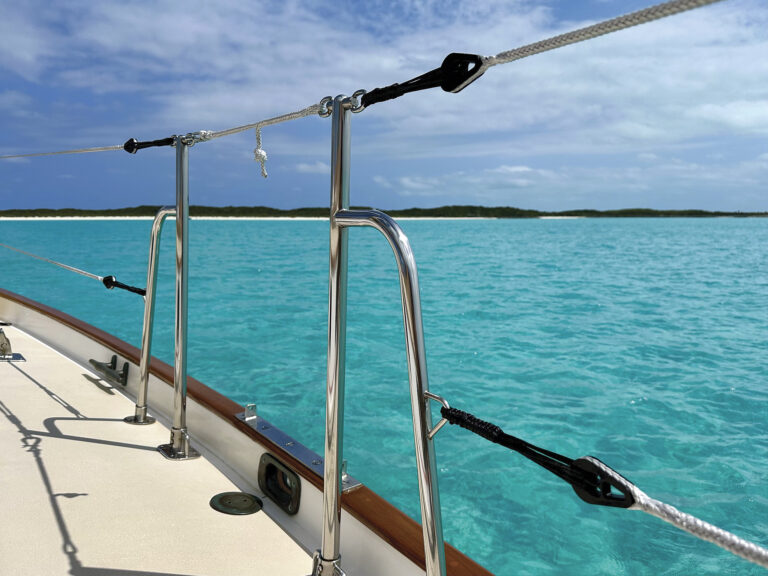
Sailing is the ultimate escapist activity. However, many of us still want to remain somewhat connected to family, friends and, alas, even work. Over the years, I have discovered a number of good techniques for staying in touch. The one I seem to use most often is “borrowing” Wi-Fi. Today, almost every restaurant or bar offers Internet, although taking advantage of this fact typically requires ordering a beer (or two), something that is easily and painlessly done. When I can’t find a Wi-Fi signal, my second line of defense is cell service. To make this work, I have to configure my phone to work as a hot spot (pretty easy to do), and then everyone on the boat can log on with his or her devices.
Of course, I also need local cell service, which generally involves acquiring a local SIM card and data plan. In some destinations, this can be a bit complicated. In French Polynesia, for example, we had to make a separate trip to a shopping mall in Tahiti to sign up with a local provider, a process that took half a day. Using a local SIM card also means I must pay local data rates, which can be very high. Finally, I need to estimate how much data I will use or find a way to “top up” on the road, which is not always easy.
Because of these unknowns, I prefer using an international cellular data service like TEP, which provides me with a pocket-size device that connects to cell service in more than 100 countries worldwide. TEP either rents the device for $9.95 a day with unlimited data or sells the unit for $99.95 and charges $8 per day for unlimited data.

I can use TEP with up to five devices. When connected to a 3G network, speeds are 7,200 KB per second (download) and 5,760 KBps (upload). Speeds drop to 512 KBps if I exceed 500 MB a day, but return to normal speeds at the start of the next 24-hour session. Making phone calls, SMS messaging or texting requires third-party apps, such as Skype or WhatsApp.
The obvious limitation with this kind of service is that I need to have a cell signal for it to work. Not only that, but these services don’t work in all countries. TEP, for example, was not available on my last trip to Namibia and won’t be available for my next trip to the Solomon Islands. That’s when satellite Internet saves the day. These devices can be expensive, but the service costs are manageable, assuming you only use them when other less-expensive options are unavailable. It’s also essential to use data wisely, like assigning a new address for e-mails during the trip and/or asking friends and clients to keep messages short and sweet.
Satellite service currently breaks down into two emerging fields: geostationary telecommunications satellites, which orbit at 22,000 miles in sync with the Earth’s rotation, and low-earth-orbit (LEO) satellites that are not in sync and orbit at much lower altitudes (500-1,000 miles).
For this article, I tested two consumer products from the top satellite signal providers: Iridium (LEO) and InmarSat (geostationary). There are some other industry-standard products out there that perform better, but they are neither cost-effective nor portable and are therefore of little use to most sailors. The service plans quoted here come from a company called Ground Control. Neither Iridium nor Inmarsat offer plans but instead work with third-party service plan providers.
For geostationary satellites, I tested Inmarsat’s product IsatHub. The advantage of this service is once I lock on, I have a very steady connection that allows me to make calls, get e-mails and even surf the Web with speeds of 384 KBps (download) and 240 KBps (upload). I can also use as many devices as I want with this device, although the manufacturer recommends limiting it to four to keep speeds up.
The unit costs roughly $1,199 (when purchased with a data plan). A use-as-you-go plan costs $50 for activation, $20 per month and $3.85 per MB transferred. Phone calls cost $0.99/min (incoming calls are free). SMS messaging/texting costs $0.50 per message (incoming SMS are free). There are also monthly plans that provide blocks of data and have lower per-MB rates.
The downside to this product is that since it connects to a fixed satellite, it does not like movement. That means I have to be anchored in a quiet bay or take the dinghy to shore—which only works if there is a shore to go to.

The Iridium LEO product I tested was the Iridium Go!, which costs roughly $799 with a service plan. The basic plan costs $49.95, has a $50 activation fee, offers five free “data-minutes” and charges $0.99 per additional data-minute. A data minute equals 144 KB, so one MB costs approximately $6.87. Just as with the IsatHub, the higher plans offer larger data packages and cheaper data fees. A slower data speed (2.4 KBps) is Iridium Go!’s biggest drawback. As such, the company recommends special data compression software to maximize efficiency. I used XGate to send and receive e-mails and PredictWind to get my weather reports. Even with these add-on products, however, surfing the Web remained very slow, sometimes even impossible.
Another glitch is I can’t use Iridium Go! as a Wi-Fi hub. This, in turn, means I need to use a special e-mail program and address, as opposed to my regular computer’s e-mail folders and address book. That said, one good thing about this situation is I can control who can send me e-mails and, by extension, my data usage. Of course, if I want to risk huge data bills, I also have the option of having my regular e-mails forwarded.
On the plus side, since Iridium Go! accesses satellites flying by at 17,000 mph, it works much better on moving surfaces (like a rocking sailboat). The unit is also half the price, half the size and one-third the weight of the IsatHub (dimensions: Iridium Go!: 4.5in x 3.25in x 1.25in, 11.6oz; IsatHub: 7.09in x 6.7in x 1.18in, 31.4oz).
In addition, Iridium is launching 75 new satellites this year, thereby replacing its entire constellation, which will improve speeds.
Note, some countries don’t allow satellite devices and have hefty fines and other consequences associated with bringing them in. So do your research. I’ve used both satellite systems in some very remote locales—including Thailand, Namibia and Malaysia—and while each has its advantages/disadvantages, both worked great for keeping me in touch. As a backup, I recommend adding an international cell data service, since it’s both cost effective and easy to pack.
All this new technology is both fascinating and essential for those who must stay connected to the world. However, those who can afford to be unplugged for a couple of days are probably OK with their radio weather reports and the occasional Wi-Fi café. I mean, isn’t that one of the reasons we love sailing—to get away from it all?
Eric Vohr (ericvohr.com) is a sailing writer with 25 years experience whose stories have appeared in newspapers and magazines all over the world.
October 2017

